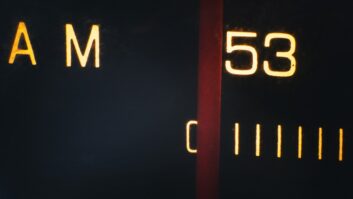
Friday’s AM revitalization order was just the start, apparently.
The Federal Communications Commission is looking beyond its new order and raising the possibility of making more and bigger changes to the AM band in the United States, including some that, if adopted, could challenge longstanding assumptions and ways of doing business — including the role of distant nighttime AM signals in American life.
These possibilities arise because in issuing its AM action order Friday, the FCC also put out a further notice of proposed rulemaking as well as a notice of inquiry. Both of those are filled with more and bigger ideas and questions that are likely to keep debate about AM’s future going for a good while, if possible raising the stakes.
Just one topic — the idea of altering protections for Class A stations — occupies three pages in the FCC’s further NPRM. There are 57 of these big stations in the continental United States (plus 16 in Alaska, with different nighttime protections). The commission now is digging into the question of whether those signals need the nighttime skywave protection they’ve had in the past. It noted that while the big footprint of Class As have historically been beneficial, the commission has reduced skywave protection before. “In this proceeding, spectrum scarcity is not the problem as much as is the need for existing AM stations to overcome an increasing noise floor that inhibits local service, both day and night.” Cutting into distant coverage by reducing protections “may well allow power increases for other stations, enabling them better to serve their communities and, in the case of some stations, allowing for the first-ever fulltime AM service to those communities.”
“Our goal of localism suggests that service from a local news and information source should be preferred over better reception of a more distant signal,” it said in something of a money quote on the issue of distant AMs. “We tentatively conclude, therefore, that (1) all Class A stations should be protected, both day and night, to their 0.1 mV/m groundwave contour, from co-channel stations; (2) all Class A stations should continue to be protected to the 0.5 mV/m groundwave contour, both day and night, from first adjacent channel stations; and (3) the critical hours protection of Class A stations should be eliminated completely. We seek comment on these proposals.”
By contrast, Class A stations in the continental United States are currently protected in the daytime to their 0.1 mV/m groundwave contour by co-channel stations, and to their 0.5 mV/m groundwave contour by adjacent-channel stations. At night, these stations are protected to their 0.5 mV/m – 50 percent skywave contour by co-channel stations, and to their 0.5 mV/m groundwave contour by adjacent-channel stations. And Class As are protected to their 0.1 mV/m groundwave contour during critical hours. So while the FCC did not put the question this way explicitly, it appears asking: Do we even need skywave protection anymore, and if so, what should it be?
The commission said that based on comments it heard in preparing its AM actions last week, current Class A protections are “the source of concern to many AM broadcasters.” It wrote that some people are in favor of reducing day and nighttime protection for the big signals, and some want to reduce or eliminate “critical hours” protection for the stations (critical hours are the two-hour periods after local sunrise and preceding local sunset). During daytime hours, some 200 Class B and D AMs must reduce power and/or change to a directional antenna to meet critical hours protection for the boomers, it wrote. During night hours, other stations often must invest in complex directional arrays to protect one of the 73 Class As and/or substantially reduce power.
“Even for those Class B stations that are protected from interference by other AM stations at night, this often results in sub-standard nighttime coverage, in order to protect the secondary service area of a larger station a considerable distance, and often many states away,” the FCC wrote. Some commenters told the commission they could “provide better service, with more power to overcome the local noise floor, if the protections to Class A stations were relaxed.”
The FCC noted the broad service areas of Class As and their benefits to rural areas and travelers, and also mentioned their role in emergencies, mentioning the work of WWL after Hurricane Katrina and its aftermath. As Radio World has reported, iHeartMedia, citing those and other arguments, has been vocally opposed to such easing of Class A protections; it owns 18 of those 57 Class As in the lower 48, and the commission IHM’s position. But the FCC said it also heard a number of suggestions for eliminating or reducing protections.
Thus the commission wants to hear from anyone who would lose service from Class A stations, and it wants information about areas and populations that may receive service only from Class As by day or night. “Conversely, we request specific comment as to the numbers of stations that would be able to increase power, daytime and nighttime, under our proposal and what populations would gain service from those power increases.” It also invited technical comment about the net effect on listeners that could result from a combination of reduced protection to Class A stations and power increases by co- and adjacent-channel stations that this proposal would allow.
Reading the NPRM, one engineering observer told RW, “It does appear the commission has decided to lob its own salvo against retaining Class A skywave protection while preferring to keep the groundwave protection contours as they are.” He is not certain that this means the entire end of skywave protections “but it’s clear to me they do want to roll back the protected limits if not eliminate them altogether. They are inviting comments and input regarding that proposal and are directly soliciting evidence that there still are listeners who rely on skywave in remote areas.”
And all of the above is merely one section in a list of possible further FCC actions.
The FCC also tentatively plans to roll back 1991 rule changes regarding calculation of nighttime RSS values of interfering field strengths and nighttime interference-free service. It proposes changes to rules providing daytime protection to AM stations, including a return to pre-1991 0 dB daytime 1:1 protection ratio for first adjacent channels (“It does not appear that the post-1991 protection ratio allows for sufficient signal strength to overcome current levels of environmental noise,” the FCC staff wrote). It also is thinking about changing second-adjacent channel groundwave protection, and eliminating third-adjacent channel groundwave protection.
It also proposes to revise its rule on siting of FM cross-service fill-in translators; to modify partial proof of performance rules; and make several changes to the rules for Method of Moments proofs. And it proposes to require the surrender of licenses by the 25 remaining dual expanded band/standard band licensees (it says it has never abandoned its requirement that those stations relinquish one of their authorizations).
It went even further, opening a Notice of Inquiry raising questions about the utilization of the AM expanded band. And it even explores the possibility of changes to the main studio requirements:
“Despite … advances in accessibility to broadcast stations and their personnel, we are reluctant to eliminate main studio requirements entirely, because of the … importance of the main studio to the goal of ensuring station compliance with local service obligations,” the FCC wrote. But it asks whether it should be more liberal with those waivers, “more open to requests by commercial stations that can co-locate in studio facilities used by co-owned stations in a given market?” And if it relaxes the requirement that each station maintain a separate main studio, is there a maximum number of co-located stations that it should allow under one roof? Should any relaxation of staffing requirements be limited to “standalone” AM stations? Should it require that cell numbers for station management and staff be posted? Should any relaxation of main studio or staffing rules be linked to a station’s posting of its public file to the FCC online database?
The part of the FCC document that outlines these many possible changes and questions are on pages 23 to 37 of the PDF. I recommend you dive into it.
There is going to be a lot to talk about in coming months.










